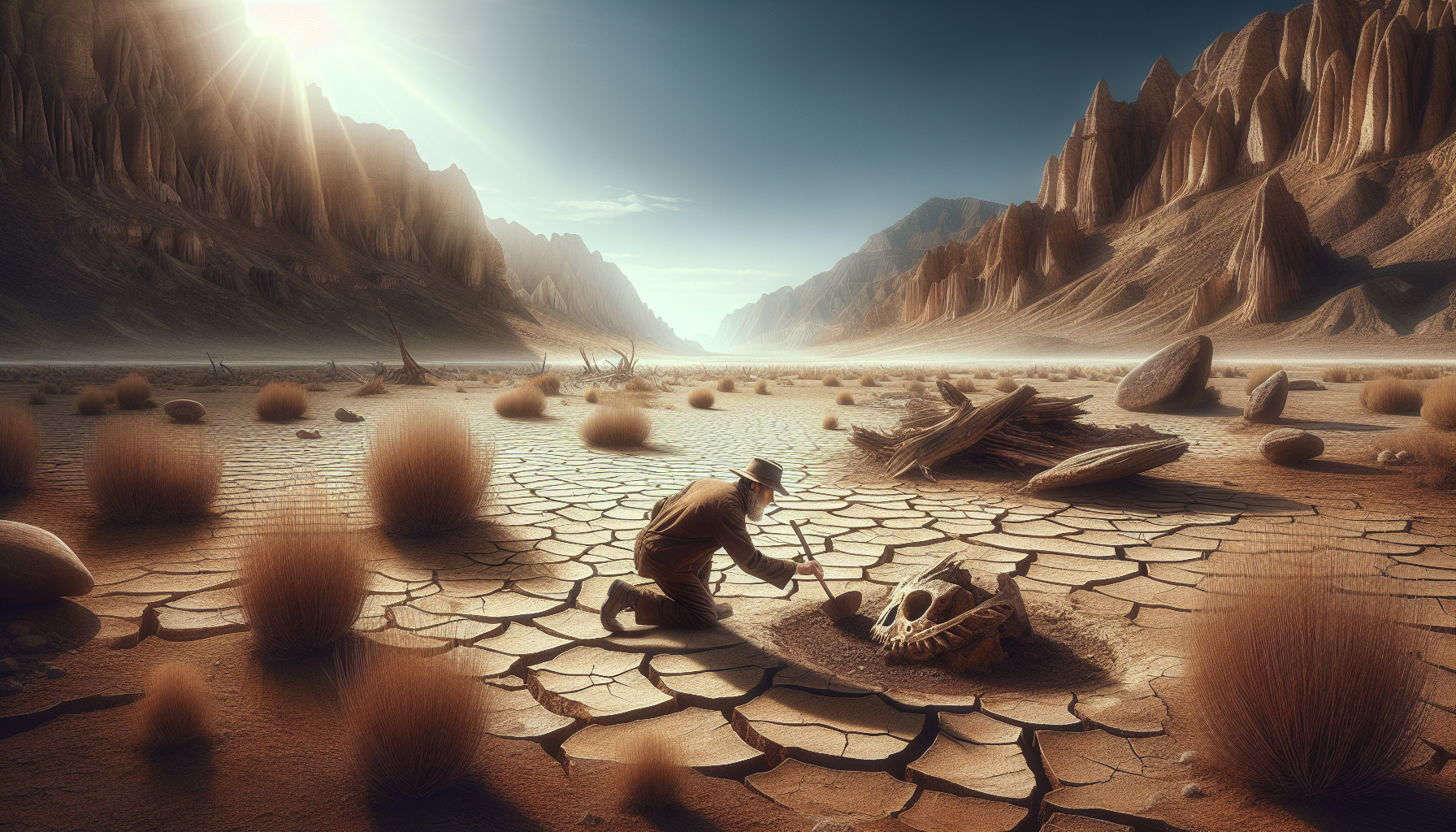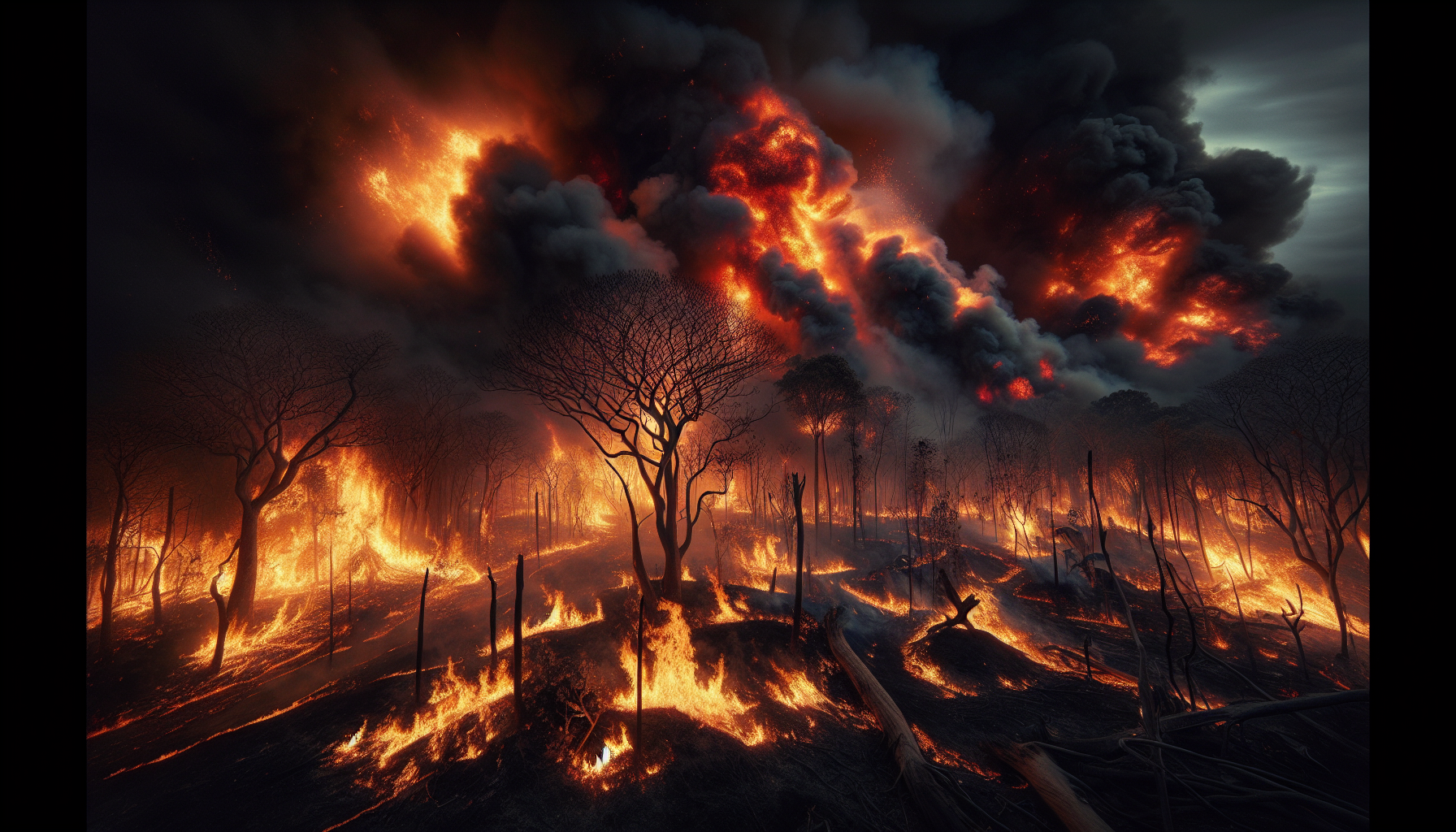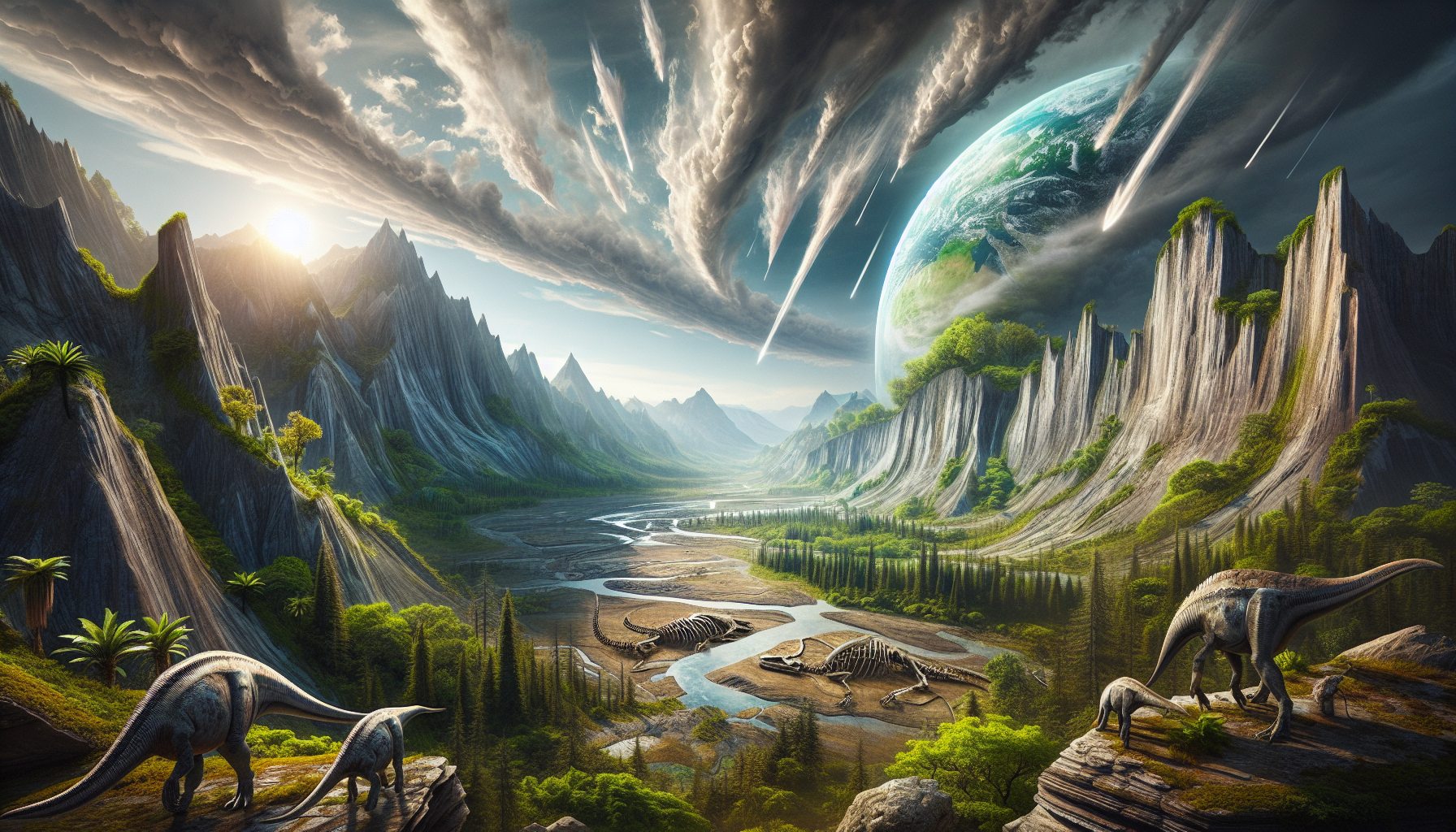In the quiet whispers of the earth, hidden beneath the sands of time, lie stories untold and mysteries unraveled. These tales, etched in the layers of rock and soil, speak of a planet in constant flux, a world that has witnessed epochs of lush abundance and stark barrenness. As we delve into the chronicles of Earth’s ancient secrets, we find ourselves drawn to a particularly pressing narrative: the saga of millennia-long droughts and the natural forces of desertification that have sculpted the face of our world. This journey through time reveals not only the resilience of our planet but also the delicate balance that sustains life as we know it. 🌍
From the Sahara’s vast expanse to the rolling dunes of the Gobi, deserts have long captured the human imagination as both beautiful and formidable. Yet, these arid landscapes are more than just geographical phenomena; they are living records of Earth’s climatic past. By uncovering the ancient patterns of drought and desertification, we can gain invaluable insights into the challenges our planet faces today. How did vast swathes of fertile land become engulfed by sand and dust? What lessons do these transformations hold for our current battle against climate change? As we embark on this exploration, we will traverse the history of these phenomena, examining the forces that have shaped them and the ongoing impact they have on ecosystems and human societies alike.
In this comprehensive exploration, we will journey through the epochs to understand how natural desertification has transformed environments and civilizations over thousands of years. We will begin by exploring the geological and climatic shifts that triggered these drastic changes, shedding light on the interplay between natural forces and human intervention. Our narrative will also delve into the science of droughts, examining how prolonged periods of dryness have influenced biodiversity and agricultural practices throughout history. Finally, we will confront the contemporary implications of these ancient processes, considering how modern technology and innovative practices might help mitigate their effects. As we uncover these stories from the past, we not only enrich our understanding of Earth’s history but also equip ourselves with the knowledge to forge a more sustainable future.
Understanding Millennia-Long Droughts
Throughout Earth’s history, prolonged periods of drought have had significant impacts on both natural environments and human civilizations. These droughts, which can last for thousands of years, are not merely extended dry spells. They are transformative events that reshape landscapes, ecosystems, and even the trajectory of human development. Understanding these millennia-long droughts involves unraveling complex climatological, geological, and anthropological data to comprehend how such phenomena occur and what they imply for our future.
Millennia-long droughts are often driven by a combination of climatic factors, including shifts in ocean currents, solar radiation variations, and changes in Earth’s orbit. One of the most well-known examples is the Holocene Epoch, a period that began approximately 11,700 years ago after the last major ice age. During this time, various regions experienced extended dry periods, leading to significant changes in the environment. For instance, the Sahara Desert, currently one of the driest places on Earth, was once a lush savanna teeming with life. Over thousands of years, a combination of decreasing rainfall and increasing temperatures transformed this verdant landscape into the arid desert we know today.
Research suggests that these long-term droughts are not only natural but are also exacerbated by human activities. Deforestation, overgrazing, and unsustainable agricultural practices can all accelerate the process of desertification, a phenomenon closely linked with prolonged droughts. The intersection of natural and anthropogenic factors creates a feedback loop that can lead to more intense and widespread dry conditions. As we continue to study ancient droughts, we gain insights into the resilience of ecosystems and human societies, as well as the strategies they employed to adapt or succumb to these environmental pressures.
The Science Behind Long-Term Droughts
To fully grasp the mechanisms behind millennia-long droughts, scientists rely on a variety of methods. Paleoclimatology, the study of past climates, provides crucial insights through the analysis of ice cores, tree rings, sediment layers, and other natural archives. These records offer snapshots of past climate conditions, revealing patterns of precipitation and temperature changes over millennia. By examining these data, scientists can reconstruct historical climate events and identify the triggers and consequences of long-term droughts.
Ice cores, in particular, are invaluable in this regard. Drilled from glaciers and ice sheets, these cores contain trapped air bubbles and other substances that can be analyzed to determine past atmospheric conditions. Similarly, tree rings provide a detailed annual record of climate variations. By studying the width and density of tree rings, researchers can infer periods of drought and correlate them with other environmental data. These methods, combined with advanced computer modeling, enable scientists to predict future climate scenarios and assess the potential risks of prolonged droughts in the context of ongoing climate change.
Another crucial aspect of understanding millennia-long droughts is examining their impact on biodiversity. Prolonged dry conditions can lead to the loss of habitats, shifts in species distribution, and even extinctions. However, some species have evolved remarkable adaptations to survive in arid environments. Understanding these adaptations can offer insights into the resilience of ecosystems and inform conservation strategies aimed at mitigating the effects of future droughts.
Impact of Natural Desertification
Natural desertification is a process that transforms fertile land into desert as a result of climatic changes and human activities. It is often characterized by the degradation of vegetation, soil erosion, and a decline in water resources. The impact of natural desertification is profound, affecting not only the environment but also the socio-economic stability of communities that depend on these ecosystems for their livelihoods.
One of the most significant impacts of desertification is the loss of arable land. As soil becomes increasingly dry and infertile, agricultural productivity declines, leading to food insecurity. This is particularly concerning in regions where subsistence farming is the primary source of food and income. The loss of vegetation also contributes to a decrease in biodiversity, as plants and animals that rely on specific habitats struggle to survive in the altered environment. The ripple effects of desertification can lead to the displacement of populations, increased competition for resources, and heightened conflict over land and water.
To combat the devastating effects of desertification, various strategies have been implemented worldwide. These include sustainable land management practices, reforestation efforts, and the restoration of degraded lands. For example, the Great Green Wall initiative in Africa aims to restore 100 million hectares of degraded land by 2030, creating a mosaic of green and productive landscapes across the continent. Such efforts not only help to mitigate the effects of desertification but also promote biodiversity, enhance food security, and support local economies.
Comparison of Desertification Impacts
The impacts of desertification can vary significantly depending on the region and the severity of the process. The table below provides a comparative overview of the impacts in different regions:
| Region | Impact |
|---|---|
| Africa | Severe loss of agricultural land, food insecurity, displacement of communities. |
| Asia | Decline in water resources, soil degradation, increased risk of natural disasters. |
| North America | Soil erosion, loss of biodiversity, economic losses in agriculture. |
| Australia | Water scarcity, habitat loss, challenges to indigenous communities. |
Understanding these impacts is crucial for developing targeted interventions that address the specific challenges faced by different regions. By adopting a holistic approach that integrates scientific research, policy-making, and community engagement, we can work towards a more sustainable and resilient future.
Adaptation Strategies and Future Implications
As the threat of desertification and prolonged droughts continues to loom, developing effective adaptation strategies is essential. These strategies must encompass not only environmental management but also socio-economic considerations. One approach is to enhance water management systems to ensure efficient use and conservation of water resources. This includes the implementation of rainwater harvesting techniques, improved irrigation practices, and the development of drought-resistant crop varieties.
Moreover, community-based initiatives play a pivotal role in building resilience to drought and desertification. Empowering local communities to participate in land management decisions, providing education on sustainable practices, and fostering collaboration among stakeholders can lead to more effective and lasting solutions. Additionally, investing in technology and innovation can drive the development of new tools and methods to combat the impacts of desertification. For instance, the use of satellite imagery and data analytics can improve monitoring and early warning systems, allowing for timely interventions.
The implications of failing to address the challenges of desertification and long-term droughts are dire. Without effective strategies, millions of people could face displacement, increased poverty, and reduced access to essential resources. However, by taking proactive measures and leveraging scientific advancements, we can mitigate the risks and ensure a sustainable future.
For those interested in further exploration, I encourage you to consult reputable sources and engage with ongoing research in this field. Websites like the National Oceanic and Atmospheric Administration (NOAA) www.noaa.gov and the Intergovernmental Panel on Climate Change (IPCC) www.ipcc.ch provide valuable resources and updates on climate science and policy. By staying informed and active, we can contribute to a more resilient and sustainable world.

Conclusion
As we draw to a close on our exploration of Earth’s ancient secrets, focusing on millennia-long droughts and the profound effects of natural desertification, it becomes evident just how pivotal understanding these phenomena is for our present and future. Throughout this article, we delved into the historical patterns of climate change, examined scientific studies that unearth the traces of ancient droughts, and analyzed the consequences of natural desertification on ecosystems and human societies. Now, let’s recapitulate these essential points and reflect on their significance.
At the heart of our discussion lies the undeniable truth that Earth’s climate has always been dynamic, with periods of drastic change often spanning thousands of years. We explored how paleoclimatology, the study of ancient climates, allows scientists to uncover the climate conditions of our planet’s past. Through meticulous analysis of ice cores, tree rings, and sediment layers, researchers have reconstructed climatic patterns, revealing evidence of prolonged droughts that have dramatically reshaped landscapes and human civilizations. This historical perspective is crucial, as it provides a baseline to understand current climate trends and potential future scenarios.
The impacts of these historical droughts were multifaceted and often devastating. Natural desertification, driven by long-term drought conditions, led to the transformation of fertile lands into barren deserts, altering habitats and threatening biodiversity. The collapse of ancient civilizations, such as the Akkadian Empire and the Maya, serves as a stark reminder of how vulnerable human societies are to environmental changes. These historical lessons emphasize the need for modern societies to build resilience and adapt to similar challenges posed by climate change today.
In exploring the science behind these phenomena, we highlighted key studies that contribute to our understanding of natural desertification. For instance, research conducted on the African Sahel region and the Dust Bowl era in North America provided insights into the mechanisms and triggers of desertification processes. These studies underscore the complexity of climate systems and the intricate interplay between natural and anthropogenic factors in shaping environmental outcomes.
Moreover, the significance of this topic extends beyond academic inquiry; it is intimately tied to pressing global issues such as food security, water scarcity, and sustainable development. As climate change accelerates, the risk of prolonged droughts and desertification increases, posing serious threats to agriculture, livelihoods, and the well-being of millions. This reality calls for immediate action and innovative solutions to mitigate these impacts and ensure a sustainable future.
Reflecting on these points, it becomes clear that the study of Earth’s ancient secrets is not merely an academic pursuit but a vital component of our collective effort to address contemporary challenges. By learning from the past, we gain valuable insights that can inform our strategies to combat climate change, protect ecosystems, and build resilient communities. The knowledge garnered from paleoclimatology and desertification studies empowers us to make informed decisions and adopt sustainable practices that prioritize environmental conservation and social equity.
As we conclude, I urge you to take these insights to heart and consider how they can be applied in your own context. Whether you’re an academic, policymaker, or concerned citizen, your engagement is crucial in shaping a sustainable future. Share this article with your network, spark discussions about the importance of understanding historical climate patterns, and advocate for policies that address the root causes of climate change. Together, we can foster a global dialogue that prioritizes the health of our planet and the well-being of future generations.
In closing, let the mysteries of our ancient Earth inspire us to act decisively and collaboratively in the face of contemporary challenges. 🌍 Together, we can uncover solutions that honor our planet’s past while securing its future. Thank you for joining this journey of discovery, and may it propel you towards meaningful action in your own sphere of influence.
Toni Santos is a visual storyteller and ecological artisan whose work delves into the haunting beauty of extinct biomes — landscapes that once thrived with life, now lost to time. Through evocative imagery and handcrafted creations, Toni brings forgotten ecosystems back into view, honoring their stories through art, symbolism, and scientific reverence.
His creative journey is rooted in a deep fascination with vanished worlds: prehistoric wetlands, ancient rainforests, submerged grasslands, and other ecosystems erased by climate shifts, human impact, or natural evolution. Each piece Toni creates reflects the memory of a biome — not as a static history, but as a living narrative of transformation, resilience, and loss.
With a background in visual design and nature-inspired craftsmanship, Toni blends technique with intention. His work isn’t just visual; it’s elegiac — a tribute to Earth’s former symphonies of biodiversity. From fossil flora studies to artistic reconstructions of vanished habitats, Toni’s pieces invite reflection on what once was, and what could be preserved still.
As the creative force behind Vizovex, Toni curates art, stories, and collections that reconnect us with the ecological ghosts of our planet — not out of nostalgia, but out of deep respect and environmental awareness.
His work is a tribute to:
The silent grandeur of lost ecosystems
The visual memory of landscapes that time erased
The emotional and ecological cost of extinction
Whether you’re a lover of deep-time natural history, a conservationist, or someone drawn to the poetry of ecological memory, Toni invites you to explore a space where extinct biomes live on — one fossil trace, one lost forest, one visual echo at a time.





